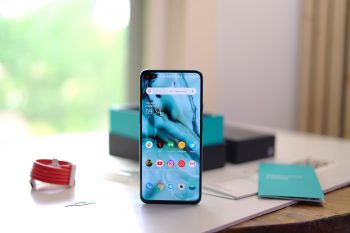
5 reasons you should buy the OnePlus Nord over the iPhone SE
After weeks of teasers and spec confirmation, the OnePlus Nord has finally arrived. The handset is slated to go on sale in the coming days, but it’s not the only mid-range smartphone to make a bunch of “noise” in 2020.
Another mid-range device that made the tech world go crazy earlier this year was Apple’s release of the new iPhone SE. For years, the SE continued to be a fan favorite due to its size, portability, and general usefulness. Despite being released back in 2016 and updated with increased storage in 2017, there was a lot of buzz around a potential successor being launched.
Fast forward to 2020 and that’s exactly what Apple did with the iPhone SE (2). The handset sports the same design as the iPhone 7 and 8, while featuring the same processor found in Apple’s iPhone 11 lineup at just half the price. So naturally, it’s interesting to compare the SE to the Nord to determine which is the king of the mid-range market.
Here are five reasons why you should pick up the Nord over the iPhone SE if you have the opportunity.
Display
One of the “best features” of the iPhone SE is the smaller 4.7-inch display. However, when comparing it to the OnePlus Nord, it’s not even a contest thanks to the Nord’s 6.4-inch screen. Not only are you getting a bigger screen with smaller bezels, but OnePlus included an AMOLED display versus the iPhone SE’s LCD panel.
But OnePlus didn’t stop there with the Nord, as you’ll also get the vastly superior and improved 90Hz refresh rate. Outside of the iPad Pro, Apple has stuck to a 60Hz display on all of its handsets, including the new iPhone SE. Once you try out 90Hz, you won’t look at displays the same.
Future-proof
5G is much more than a buzzword in 2020, as we have been seeing more carriers make their new networks available. Some smartphones can already take advantage of them, but the iPhone SE is not one of them. Meanwhile, the OnePlus Nord is equipped with Qualcomm’s Snapdragon 765G processor. This supports 5G connectivity, and when it’s time to make the switch from LTE to 5G, the Nord will be just fine.
Unleash the power
It cannot be understated just how great Apple is at optimizing the hardware, despite featuring “lesser” specs than the competition. But when comparing the SE to the Nord, it’s really no contest. In addition to already featuring the Snapdragon 765G, this chipset has been paired with either 8GB or 12GB of RAM and up to 256GB of onboard storage. For reference, the SE is only equipped with 3GB of RAM, so the Nord has four times as much as Apple’s offering.
Cameras
Some folks don’t care too much about the software, and just want a phone with a good camera without paying an arm and a leg. Apple is one of the leaders when it comes to smartphone cameras, but it’s a bit different with the iPhone SE. You’ll find a single 12MP sensor with an f/1.8 aperture on the back and a single 7MP sensor on the front.
As for the Nord, OnePlus has packed in a total of SIX different cameras, with four on the back and two on the front. The primary 48MP lens comes right from the OnePlus 8 lineup, along with an 8MP ultra-wide lens, 5MP depth sensor, and a 2MP macro lens. On the front, there’s an 8MP ultra wide lens, along the more-traditional 32MP primary camera.
Software
This is always a subject for debate, even when comparing Android flagships to the iPhone flagships. But the software is vastly superior as OnePlus is known for providing arguably the best software experience on a smartphone, outside of maybe the Google Pixel lineup. OxygenOS has a stock Android feel, with customizations that you wouldn’t expect, along with extra features that just make your phone feel like a true extension of you.
Can’t get enough of the OnePlus Nord?
- 5 reasons the OnePlus Nord will be DOA
- Four reasons the OnePlus Nord will be the best phone of 2020, and one reason it won’t
- 10 first things every OnePlus Nord owner should do
- OnePlus Nord unboxing
- The OnePlus Nord is here and it looks gorgeous